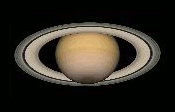Rings of Saturn
Rings of Saturn
The Rings of Saturn are the most extensive ring system of any planet in our Solar System. Comprising countless small particles, ranging in size from micrometers to meters, these rings orbit around Saturn and are primarily made of water ice, with a smaller component of rocky debris and dust. The exact origin of the rings remains a subject of research and debate, but they are believed to be remnants of destroyed moons, comets, or asteroids.
Structure and Composition[edit | edit source]
The rings of Saturn are divided into seven main sections, named alphabetically in the order they were discovered. These are the D, C, B, A, F, G, and E rings, with the A, B, and C rings being the most prominent. The Cassini Division, a 4,800 km wide region between the A and B rings, is perhaps the most well-known gap. The rings vary in density and size, with the B ring being the most massive and the E ring being the most diffuse.
Exploration[edit | edit source]
Spacecraft exploration, beginning with Pioneer 11 in 1979, followed by Voyager 1 and Voyager 2 in the early 1980s, and more recently by the Cassini-Huygens mission (2004-2017), has provided a wealth of information about the rings. These missions have revealed the complexity and dynamism of the ring system, including the presence of "propeller" features and the interaction between Saturn's moons and the rings.
Formation and Age[edit | edit source]
The age of the rings is a topic of ongoing debate. Some evidence suggests that the rings could be quite young, perhaps just a few hundred million years old, while other studies propose they might be as old as the Solar System itself, around 4.5 billion years. The debate centers around the balance between the rings' bright appearance, which suggests youth, and the processes that could have formed them early in the Solar System's history.
Scientific Significance[edit | edit source]
The rings of Saturn have provided significant insights into planetary ring dynamics, including the processes of accretion (the coming together of particles to form larger bodies) and the effects of gravitational interactions. Studying the rings also helps scientists understand more about the conditions in the early Solar System.
Cultural Impact[edit | edit source]
Beyond their scientific interest, the rings have also had a profound impact on culture, inspiring artists, writers, and filmmakers with their ethereal beauty. They symbolize the wonders of the universe and continue to captivate the public and scientific community alike.
Search WikiMD
Ad.Tired of being Overweight? Try W8MD's NYC physician weight loss.
Semaglutide (Ozempic / Wegovy and Tirzepatide (Mounjaro / Zepbound) available. Call 718 946 5500.
Advertise on WikiMD
|
WikiMD's Wellness Encyclopedia |
| Let Food Be Thy Medicine Medicine Thy Food - Hippocrates |
Translate this page: - East Asian
中文,
日本,
한국어,
South Asian
हिन्दी,
தமிழ்,
తెలుగు,
Urdu,
ಕನ್ನಡ,
Southeast Asian
Indonesian,
Vietnamese,
Thai,
မြန်မာဘာသာ,
বাংলা
European
español,
Deutsch,
français,
Greek,
português do Brasil,
polski,
română,
русский,
Nederlands,
norsk,
svenska,
suomi,
Italian
Middle Eastern & African
عربى,
Turkish,
Persian,
Hebrew,
Afrikaans,
isiZulu,
Kiswahili,
Other
Bulgarian,
Hungarian,
Czech,
Swedish,
മലയാളം,
मराठी,
ਪੰਜਾਬੀ,
ગુજરાતી,
Portuguese,
Ukrainian
Medical Disclaimer: WikiMD is not a substitute for professional medical advice. The information on WikiMD is provided as an information resource only, may be incorrect, outdated or misleading, and is not to be used or relied on for any diagnostic or treatment purposes. Please consult your health care provider before making any healthcare decisions or for guidance about a specific medical condition. WikiMD expressly disclaims responsibility, and shall have no liability, for any damages, loss, injury, or liability whatsoever suffered as a result of your reliance on the information contained in this site. By visiting this site you agree to the foregoing terms and conditions, which may from time to time be changed or supplemented by WikiMD. If you do not agree to the foregoing terms and conditions, you should not enter or use this site. See full disclaimer.
Credits:Most images are courtesy of Wikimedia commons, and templates, categories Wikipedia, licensed under CC BY SA or similar.
Contributors: Prab R. Tumpati, MD






